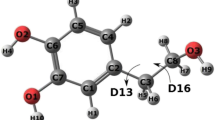Abstract
As three-dimensional models of chemical objects are essential tools for understanding their intimate structure and function, nowadays molecular graphics techniques allow building, visualizing, and manipulating, of complex molecular structures and their related properties. This paper presents several developments recently achieved in this field, namely: the representation of macromolecular structures such as proteins; the modelization of molecular envelopes as dot surfaces, mesh surfaces, and solid models; the evaluation and visualization of color-coded reactivity indices based on intermolecular interaction energies. The last application is shown to be particularly useful in several applications, such as molecular recognition and drug design.
Similar content being viewed by others
Explore related subjects
Discover the latest articles, news and stories from top researchers in related subjects.References
Allen FH, Kennard O, Taylor R (1983) Systematic analysis of structural data as a research technique in organic chemistry. Acc Chem Res 16:146–153
Berthelot MPE (1886) Science et philosophie. Calmann Levy, Paris
Breck DW (1974) Zeolite molecular sieves. Wiley, New York
Brickmann J (1988) Molcad molecular modeling package. Technische Hochschule, Darmstadt, FRG
Brooks BR, Brumcoleri RE, Olafson BD, States DJ, Swaminathan S, Karplus M (1983) Charmm: a program for macromolecular energy, minimization, and dynamics calculations. J Comput Chem 4:187–217
Cherfils J, Vaney MC, Morize, I, Surcouf E, Colloc'h N, Nornon JP (1988) Manosk: a graphics program for analyzing and modeling molecular structure and functions. J Mol Graph 6:155–160
Chinn MS, Heinekey DM (1987) Synthesis and properties of a series of ruthenium dihydrogen complexes. J Am Chem Soc 109:5865–5867
Connolly ML (1981) Molecular surface calculation. QCPE, program 429
Connolly ML (1983) Solvent-accessible surfaces of proteins and nucleic acids. Science 221:709–713
Conroy-Lewis FM, Simpson SJ (1987) Molecular hydrogen complexes: the effect of steric factors on the protonation of the monohydrides [(η5-C5H5)Ru(Ph2P(CH2) n PPh2)H] (n=1,3). J Chem Soc Chem Commun 1675–1676
Cretegny I (1990) PhD thesis, in preparation
Dubois JE (1974) DARC system in chemistry. In: Wipke WT, Heller S, Feldmann R, Hyde E (eds) Computer representation and manipulation of chemical information. Wiley, New York, pp 239–263
Dubois JE, Laurent D, Weber J (1985) Chemical ideograms and molecular computer graphics. The Visual Computer 1:49–63
Fleming I (1976) Frontier orbital and organic chemical reactions. Wiley, Chichester
Fluekiger P (1990) PhD thesis, in preparation
Frühbeis, H, Klein R, Wallmeier H (1987) Computer-assisted molecular design (CAMD) — an overview. Angew Chem [Int Ed Engl] 26:403–418
Goldblum A, Pullman B (1978) Study of anion binding to protonated nucleic acid bases using electrostatic molecular potentials. Theoret Chim Acta 47:345–347
Goursot A, Fajula F, Figueras F, Daul C, Weber J (1990) Molecular-graphics modelling of the acid strength in zeolites: influence of the aluminium distribution in offretite. Helv Chim Acta 73:112–121
Hassanaly P, Dou H (1986) Online access to chemical information. In: Vernin G, Chanon M (eds) Computer aids to chemistry. Ellis Horwood, Chichester, pp 334–375
Hoffmann R (1963) An extended Hückel theory: I. Hydrocarbons. J Chem Phys 39:1397–1412
Kahn SD, Pau CF, Overman LE, Hehre WJ (1986) Modeling chemical reactivity: I. Regioselectivity of Diels-Alder cycloadditions of electron-rich dienes with electron-deficient dienophiles. J Am Chem Soc 108:7381–7396
Karplus M, McCammon JA (1986) The dynamics of proteins. Sci Am 254:30–39
Lee B, Richards FM (1971) The interpretation of protein structures: estimation of static accessibility. J Mol Biol 79:379–400
Lehn JM (1988) Supramolecular chemistry — scope and perspectives: molecules, supermolecules, and molecular devices (Nobel lecture). Angew Chem [Int Ed Engl] 27:89–112
Lesk AM (1977) Macromolecular marionettes. Comput Biol Med 7:113–129
Lorensen WE, Cline HE (1987) Marching cubes: a high resolution 3D surface construction algorithm. Comput Graph 21:163–169
Marshall GR (1987) Computer-aided drug design. Annu Rev Pharmacol Toxicol 27:193–213
Max NL (1984) Computer representation of molecular surfaces. J Mol Graph 2:8–13
Morokuma K (1977) Why do molecules interact? The origin of electron donor-acceptor complexes, hydrogen bonding, and proton affinity. Acc Chem Res 10:294–300
Nelson S (1988) Chemistry beyond the molecule. Chem Britain 24:752–753
Osawa E, Musso H (1983) Molecular mechanics calculations in organic chemistry: examples of the usefulness of this simple non-quantum mechanical model. Angew Chem Int Ed Engl 22:1–12
Panaye A, Doucet JP, Cayzergues P, Carrier G, Mathieu G (1988) L'élucidation structurale: des données spectrales à la reconnaissance moléculaire. L'Actualité Chimique 4–5:103–112
Ramdas S, Thomas JM, Betteridge PW, Cheetham AK, Davies EK (1984) Modelling the chemistry of zeolites by computer graphics. Angew Chem [Int Ed Engl] 23:671–679
Rhodes P (1985) Chemical structures on-line. Chem Britain 21:53–58
Richards FM (1977) Areas, volumes, packing and protein structure. Annu Rev Biophys Bioeng 6:151–176
Richardson JS (1981) The anatonomy and taxonomy of protein structure. Adv Protein Chem 34:167–339
Shimomura S, Kikuchi O (1987) Reaction potential map analysis of site selectivity of acrylic acid and acrylonitrile. J Mol Struct Theochem 150:289–295
Solladie-Cavallo A (1985) Arene-chromium tricarbonyl complexes: bonding and behaviour. Polyhedron 4:901–927
Weber J, Roch M (1986) Computer graphics applications of electron deformation densities and electrostatic potentials in coordination chemistry. J Mol Graphics 4:145–148
Weber J, Fluekiger P, Morgantini PY, Schaad O, Goursot A, Daul C (1988a) The modelling of nucleophilic and electrophilic additions to organometallic complexes using molecular graphics techniques. J Comp Aid Mol Design 2:235–253
Weber J, Fluekiger P, Ricca A, Morgantini PY (1988b) Recent developments in molecular graphics. In: Barth H (ed) Visualisierungstechniken und Algorithmen. Springer, Berlin, pp 17–30
Weber J, Morgantini PY, Leresche J, Daul C (1989) Molecular graphics as a tool for modelling nucleophilic and electrophilic reactions in organometallic chemistry. In: Carbo R (ed) Quantum chemistry: basic aspects, actual trends. Elsevier, Amsterdam, pp 557–576
Weiner PK, Kollman PA (1981) Amber: assisted model building with energy refinement. A general program for modeling molecules and their interactions. J Comput Chem 2:287–303
Weiner PK, Langridge R, Blaney JM, Schaefer R, Kollman PK (1982) Electrostatic potential molecular surfaces. Proc Natl Acad Sci USA 79:3754–3758
Author information
Authors and Affiliations
Rights and permissions
About this article
Cite this article
Weber, J., Morgantini, PY., Fluekiger, P. et al. Recent developments in molecular graphics: visualization of chemical structures and properties. The Visual Computer 7, 158–169 (1991). https://doi.org/10.1007/BF01901186
Issue Date:
DOI: https://doi.org/10.1007/BF01901186




